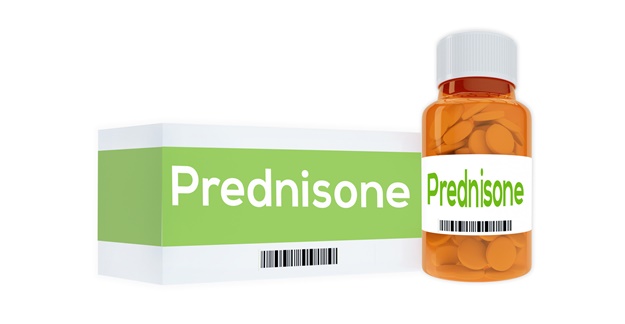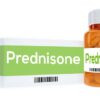If you visit the doctor from time to time for anything other than a routine checkup, it’s likely that at some point you’ve received a prescription for a type of drug called corticosteroids. These are commonly prescribed in the US, and they are used in almost every medical specialty.
In a study of short-term corticosteroid use, researchers at the University of Michigan found that one in five American adults with commercial health insurance had been prescribed a median of six days of corticosteroids at least once over a three-year period.
While its importance is undeniable, you should know corticosteroids such as prednisone come with downsides — a long list of side effects and interactions with numerous other medications. Corticosteroid use is a common reason people are admitted to hospitals due to drug-related adverse events.
Benefits of Prednisone
One of the most widely used corticosteroids is prednisone, a “manufactured hormone similar to the natural hormone, cortisone, produced by humans,” according to Norman P. Tomaka, BSPharm, MS, a media liaison for the American Pharmacists Association and consultant pharmacist and healthcare risk manager based in Melbourne, Fla.
“Prednisone is an anti-inflammatory drug that reduces the body’s immune response in order to manage many different health conditions, including breathing problems, severe allergies, inflamed skin, serious eye swelling, serious arthritis, bowel disorders, blood disorders, certain cancers, and multiple sclerosis flares,” said Tomaka. Researchers are investigating the potential use of corticosteroids during the late phases of infection in patients with COVID-19, with mixed results so far, including some research showing steroids may increase mortality in the disease.
Depending on the condition, the drug is used on a short- or long-term basis, and it can be taken in several ways, including pill or liquid form. Along with the extensive number of ailments that it may relieve, there are lots of benefits associated with prednisone treatment when prescribed appropriately. For example, it is a rapid-acting medication, meaning it gets to work quickly once taken. It can also be adapted to a “variety of dosing schedules tapered to the patient’s specific condition and length of treatment,” Tomaka explained.
Risks of Prednisone
More serious side effects, such as an increased risk of infections, psychological effects, weakening of bones, and bone fractures are associated with longer-term use.
Mixing corticosteroids such as prednisone and anticoagulant medicines (e.g., heparin, warfarin, dabigatran, apixaban and rivaroxaban) can make anticoagulants less effective. Also, combining NSAIDs (non-steroidal anti-inflammatory drugs) such as aspirin, ibuprofen, diclofenac, and naproxen with corticosteroids increases your risk of developing stomach ulcers and internal bleeding.
When used short-term, prednisone is generally well-tolerated, and when side effects do occur in this scenario, they usually clear up quickly after treatment ends. Even with short-term use, however, some people do experience side effects such as fluid retention, weight gain, fatigue, increased blood sugar, stomach irritation, irritability and increased alertness and hunger. A July 2020 study in the Annals of Internal Medicine found that taking corticosteroids for as short a period as three days may increase the risk for serious adverse events. The researchers found that rates of gastrointestinal bleeding, sepsis (widespread inflammation commonly triggered by a bacterial infection), and heart failure significantly increased within five to 30 days after treatment began.
In the University of Michigan study mentioned above, there was a major increase — by up to five times — in rates of several adverse events, particularly sepsis, venous thromboembolism (a blood clot in a deep vein) and bone fracture, in patients who were on corticosteroids for a short time. These issues occurred even at low doses, and the higher risk of adverse effects lingered even weeks or months after patients stopped taking the drug.
You should also be aware there is the potential for psychological side effects. Prednisone affects areas of the brain that manage the regulation of different neurotransmitters, including serotonin and dopamine — both of which can impact mood.
When fitness instructor Gabriela Correa suddenly developed a red, itchy rash over most of her body, her dermatologist prescribed a one-week course of prednisone. After a few days of taking it, however, Correa felt noticeably more anxious — she was “freaking out for no reason,” as she put it — and had trouble falling and staying asleep. She called her doc, who advised her to stop taking prednisone. Fortunately, most of the rash had already cleared up by then, so no further treatment was needed, and she did not experience any additional problems related to the medication.
When prednisone is used on a long-term basis for the treatment of a serious medical condition, patients should be monitored for negative effects that may include a reduced ability to fight infection, reduced wound healing, softening of bones, skin discoloration, increased sweating, mood swings and behavioral changes, digestion problems, muscle weakening, glaucoma and decreased sex drive.
People on long-term corticosteroid therapy are considered to be at high risk for COVID-19. In a 2020 report in The Journal of Clinical Endocrinology & Metabolism, experts note that patients taking corticosteroids may be more susceptible to COVID-19 due to the immunosuppressive effects of the steroids. In addition, problems caused by the underlying disease the drugs are prescribed for or immunosuppressive actions of other drugs prescribed in conjunction with the steroids may also contribute to higher susceptibility to COVID-19.
Staying Safe
If your healthcare provider recommends prednisone, Tomaka offers the following tips about how to avoid side effects:
- Before starting prednisone, be sure to communicate with your prescriber regarding the details of your past medical history and all medications you are taking or have taken recently.
- Do not take more than the dose prescribed.
- Take the medication at the time of day directed by the prescriber.
- Take each dose with food or milk to prevent stomach irritation.
- Avoid alcohol and other irritating foods and beverages while taking prednisone.
- Finish your course of treatment as instructed by the prescriber.
There are certain signs that might point to a more serious problem that requires more immediate attention. If you develop any of the following symptoms, you should promptly call your healthcare provider for immediate guidance:
- Any blood in your stool.
- Nausea and/or vomiting.
- Constipation or diarrhea.
- Chest pain.
- Visual disturbances.
- Serious swelling in your ankles and/or feet.
- New infection or wounds.
- Fever.
- Increased or decreased blood pressure.
- Serious behavioral disturbances, such as hallucinations or delusions.
“Most patients benefit from short-term prednisone treatment, while others require low-dose maintenance therapy with medical supervision and routine lab work,” Tomaka said. “Depending on the condition treated, the benefit of using prednisone may outweigh the risks.”
Research is underway to develop safer alternatives to prednisone. For example, an experimental drug called vamorolone improved muscle function in a 2019 study of boys with Duchenne muscular dystrophy, a disease characterized by progressive muscle weakness and wasting, primarily affecting young boys and often treated with prednisone. Boys treated with vamorolone experience fewer adverse events, including less weight gain, bone loss and insulin resistance, compared to boys treated with prednisone.
Closely following prescription instructions, clearly communicating with your provider about your health and medication history, and keeping an eye out for signs of a negative reaction can help you reap the intended benefits of prednisone while minimizing its many potential risks.






